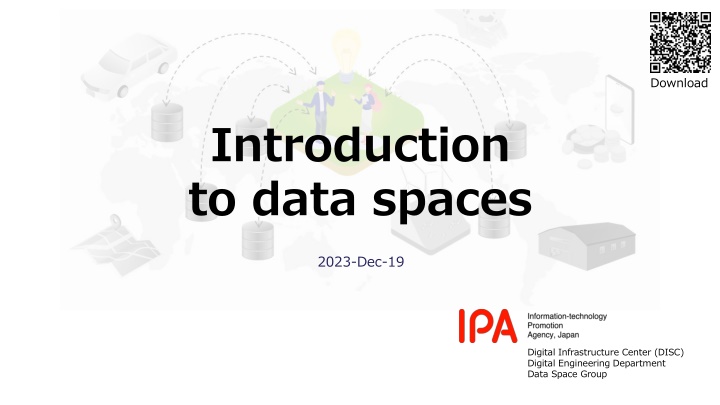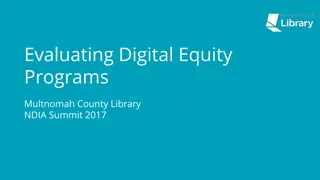Exploring the Potential of Data Spaces in the Digital Economy
Delve into the concept of data spaces as a standardized mechanism facilitating secure and reliable data sharing across organizations and industries globally. Learn about the advantages of data spaces in driving economic development, addressing social issues, and fostering innovation. Discover how data spaces contribute to the realization of Society 5.0, offering a glimpse into the future of data-driven management and sustainable societies.
Download Presentation

Please find below an Image/Link to download the presentation.
The content on the website is provided AS IS for your information and personal use only. It may not be sold, licensed, or shared on other websites without obtaining consent from the author.If you encounter any issues during the download, it is possible that the publisher has removed the file from their server.
You are allowed to download the files provided on this website for personal or commercial use, subject to the condition that they are used lawfully. All files are the property of their respective owners.
The content on the website is provided AS IS for your information and personal use only. It may not be sold, licensed, or shared on other websites without obtaining consent from the author.
E N D
Presentation Transcript
Download Introduction Digital Infrastructure Center Digital Engineering Department data space group to data spaces 2023-Dec-19 Digital Infrastructure Center (DISC) Digital Engineering Department Data Space Group
About this document This document is for beginners who want to learn about "Data Spaces . The Purpose is to understand, - What are data spaces - What is the organizational structure for data spaces promotion - What use cases are expected in Japan 2
Background: global data spaces initiatives EU, US, and China are increasing their competitiveness and influence by being ambitious over data linkage methods. It is imperative that measures be taken in Japan's domestic industry. EU USA/China Data spaces from the social economic activity data accumulation Data spaces from the personal economic activity data accumulation Data collection Develop data infrastructure and rules to collect large amounts of data from society. Data collection Huge companies alone collect vast amounts of personal data. Activities Utilize big data collected by platformer to develop services. Activities Data collaboration across countries and organizations can now be done securely and quickly, and the use of data by companies will rapidly advance. International standardization led by the EU De facto standardization led by stand-alone companies 3
What are data spaces? Concept that focuses on indispensable data in the digital society. Standardized mechanism that ensures reliability and data sharing among different organizations, countries, and different industries ecosystems. - Large amount of "diverse" and "reliable" data can be used with security. - - International expansion/cooperation Data providers Data consumers (Use cases) Data spaces * Data is retained by the provider, not centrally. EU Cross-industry/cross- sectoral (cross domain) data spaces data spaces Energy industry data spaces Manufacturing industry data spaces Use data IoT US data data spaces data data AI Utilization Smart city Financial industry data spaces Distribution industry data spaces India Administrative field data spaces data spaces data ASEAN data spaces data Use data digital infrastructure Reference model Common services Common functions Digital Data analysis Digital DFFT infrastructure Transformation (Data Free Flow With Trust) Reliable and free data flow 4
Advantages of data spaces Widespread use of data spaces will contribute to the realization of "Society 5.0 *1," which combines economic development through data-driven management and solutions to social issues. Business benefits Realization of data-driven management Social benefits Privacy and a better life for everyone 1. Business speed improvement Anyone can easily and quickly start a new business using data. 1. Sustainable Enables the realization of a green society. Analyze energy consumption data & use energy resources efficiently. 2. New business development People with diverse expertise can work together for problems. 2. Knowledge/ convenient (by digital technology) Optimize transportation systems using traffic data to ease congestion and reduce travel time. Provide more accurate weather forecasts by combining existing weather data with IoT data, for example. 3.Better marketing strategy and early detection of problems Advanced data analysis to discover new patterns and trends and provide useful information. 3. Safe and secure Forecasting: Predict future events (natural disasters, health crises, etc.) and mitigate risks. Disaster prevention: Ensure rapid evacuation guidance. 4. Adding value to data owned by the organization Create value from data that has not previously been valued. 4. Equality and less disparity Education (research data, education statistics, learning methods, etc.), Business (businesses using data) will have equal opportunities. 5. Improved data security and cyber attack countermeasures Confidentiality (can exchange data with trusted parties). Integrity (can prevent data tampering) can be ensured. 5 *1 Society 5.0 is a data-driven society promoted by the government of Japan.
Active and Inevitable aspects of data spaces Sharing is inevitable and should be actively shared, by the concept of data sovereignty. Data sovereignty Active perspective To enhance competitiveness, proactively utilize data linkage in business - Data sovereignty" is a fundamental concept for trusting and sharing data in the data spaces. Data providers can decide to whom and for how long data will be provided, etc. - New business development Utilize data from different industries Problem solving 1. Rights reserved by data provider Analyze from a new perspective Data spaces Inevitable perspective Data Data Data Obligation and necessity, it is necessary to coordinate with regulations and international rules. Data is managed by data owner Data is not centrally managed 2. Limited sharing to specific users Regulatory compliance Necessity to comply with the rules Prevention of isolation Other than Japan Use data space Permission NG Example: EU General Data Protection Regulation ( GDPR ) etc. 6
The image of data space characteristics and data exchange Interoperability and Data sovereignty are particularly important characteristics of data spaces. Three main steps for collaboration between data spaces - first, data retrieval, second, authentication/authorization, and third, data transfer/access. Digital infrastructure Fairness Commonly used tools and services Data sovereignty Data rights Available to anyone Data catalog cross search Building Blocks Common services/tools Common functions Data user Data provider Data catalog Publication of catalog site Trust Ensuring the reliability of the other party Distributed service and data The provider holds each data Machine Usable Available on computer Contract Contract Connector Connector Authentication/ Authorization Use in application Authentication/ Authorization Data 2. User authentication/authorization Data Data Data acquisition 3. Data transfer / access Use in Data provided data analysis A industry data spaces B industry data spaces C industry data spaces Interoperability Can exchange data with different parties X industry 7
"Connector" that realizes data exchange - By using connector, providers and users can connect each other and exchange the data. - Connector is like Outlet . "Appliances" can receive "electricity" by using the common Outlet". "Apps" can access "data" by using a common Connector". Outlet Connector Data Connector Electricity App N Data Electricity App T Data Electricity App S 8
Benefits of using connector When developing data exchange applications, the provided connector can be used to reduce the cost and time required for design and development. Without connector With connector Design and development of data transfer with specific counterparties is necessary. Reduce cost and time by using connectors App App Preprocessing Preprocessing Use provided connector Design and development Authentication/ Authorization (provided) connector Data exchange function Burden the cost and time Reduce the cost and time Post-processing Post-processing 9
Digital infrastructure Digital Infrastructure provides common services, tools, functions, and reference models underlying the data space in addition to connectors. Common services and tools Need to accelerate maintenance Cross industry cross sectoral cross domain data spaces nergy industry data spaces anufacturing industry data spaces Io data data data Common functions inancial industry data spaces Distribution industry data spaces Administrative eld data spaces - Rule - Standard - Data model GIF data data data Vision Priority domain Strategy / Policy Reference models data model Guidebook eference model Common services Common functions Legislation Regulation Rule Coordination Team Organization Business process Business Rule Security / Authentication Business Data harness functions Catalogue, Search, AI, Analysis Data definition, Data model, Code Data Data broker function Gathering, Integration, Cleansing, Device management Sensor, Actuator, Hardware, Network Asset xample of common services, tools and Building blocks (common function) Lifecycle 1. Data search 2. Authentication/ Authorization 3. Data exchange 4. Data utilization 5. Development environment 6. Guideline Knowledge Data catalog ID service Connector AI/Analysis OSS catalog Teaching materials Visualization Test bed Data dictionary Access control Broker Base registry Log management Delivery Knowledge Base Test data Market place Billing management Data management 10
Differences from other data sharing structure Comparing traditional data management and the structure of the data space is decentralized for reliability, interoperability, and data sovereignty *1. EAI Platformer type Data spaces (Enterprise Application Integration) *2 Structure type Distributed Structure type Centralized Structure type Federated Characteristic Mechanism for exchange data between systems within a company. Characteristic Can ensure reliability and share data between different organizations and countries Characteristic Platforms hold & handle data. Sovereignty N/A Sovereignty N/A Sovereignty Yes Example Google Example Catena-X Example Data Spider Sales Company Cloud User Company Company User management system Data Data Data Data Data Connector Connector Data exchange function Data exchange function (centralized management) EAI Company Company EDI Accounting management system Company Company User Data Data Connector Data Connector Data Data exchange function Data exchange function *1: Whether or not the data provider can be involved in the handling of its own data. 11 *2: System that links multiple systems used for business within a company to efficiently integrate data and processes.
Role in acceralating data spaces in Japan Government of Japan, DSA, and IPA plan to work together to promote data spaces. Policy/Strategy Vision, Scope Laws, Regulations, Implementing agencies, Management organization Legal rules, Organization Japan Using data spaces for services, solutions Business, Function One Team Digital Agency Ministry of Economy, Trade and Industry Related ministries Information-technology Promotion Agency (IPA) * National Printing Bureau * Japan Institute for Local Government Information Systems (J-LIS) * National Institute of Information and Communications Technology (NICT) * Data Society Promotion Council (DSA) ... Data space across industries and sectors Data space by industry and sector Data spaces Digital infrastructure ( framework, platform ) Development environment Data catalog Dictionary, ID Common service tools Connector access control Common functions Data utilization Technical rules data model, vocabulary Guideline Reference model * Strengthening cooperation is stated in the priority policy program for realizing a digital society. Base registry Open data Data IoT/Sensor, Hardware, Network Assets (Equipment/System) 12
Area of the data space Data spaces are used in a wide range of fields in society. Japan Standard Industrial Classification : Major Classification A. Agriculture, forestry B. Fishery C. Mining, Quarrying, Gravel extraction EU Japan EDS agriculture Fishing - Semi-public (agriculture) - - Smart buildings, Underground objects Land Transport PF Intercompany transactions, Batteries Water supply - Autonomous mobile robot Mobility (service) - Finance Land Transport PF In each field, one or more projects are underway, and there are many data spaces with limited functions or regions. EDS construction D. Construction EDS Industry / Industrial, Mobility EDS energy EDS media EDS railway, mobility, aviation, shipping - EDS Finance - E. Manufacturing F. Electricity, Gas, Heat supply, Water industry G. Information and communication H. Transportation industry, Postal industry In Japan, there are many initiatives similar to data spaces. I. Wholesale trade, Retail trade J. Financial industry, Insurance industry K. Real estate business, Goods rental business L. Academic research, Professional / Technical services industry M. Accommodation industry, food service industry EDS tourism N. Life -related service industry, Entertainment industry O. Education , Learning support industry P. Medical care, Welfare Q. Complex service business R. Service industry (n.e.c.) EDS cultural heritage - - EDS tourism - EDS skills EDS health EDS smart community - EDS administration, Administration (law, procurement, safety) EDS green deal Public Service Public Service Public Service - Public personal authentication Public service S. Public service (excluding those classified elsewhere) CFP carbon footprint T. Unclassifiable industries 13 * EDS: European Data Spaces
Case study (1) - Osaka City S y o Data spaces focus point Establishment of a digital infrastructure for industry-academia-government collaboration to eliminate the administrative digital divide within Osaka. The usage of the catalog enables the provision of services utilizing Osaka open data. Expected benefits Background There was a disparity in efforts to utilize data among municipalities in Osaka Prefecture due to financial, human resources, know-how, and other limitations. Aim for a society where all residents can access advanced digital services. Business 1. Business speed improvement 2. New business development 3. Better marketing strategy, catch the detection earlier 4. Adding value to data owned by the organization 5. Improved data security and cyber attack countermeasures Social 1. Sustainable society 2. Knowledge society / convenient society (utilization of digital technology) 3. Safe and secure society 4. A society with equality and less disparity Effort Osaka Prefectural Government will take the lead in making ID sharing possible starting in FY2022. Establish a digital infrastructure and start providing services. Establish an environment to provide a variety of digital services to those who need them, when they need them. Focus points of this case Digital infrastructure Effect -> 43 municipalities in Osaka can share the usage of data and services that were previously disparate or fragmented. ID sharing -> Enables services to be linked and can provide personalized services. Increased digitization of business operations improves operational efficiency. Development of Osaka digital infrastructure Data user Data provider ublication of catalog site o o Authentication Authori ation Authentication Authori ation Data . ser authentication authori ation Data Data . Data transfer access Data provided A industry data spaces industry data spaces C industry data spaces industry 14
Case study (2) - Sapporo City M k o m z o Data spaces focus point - Establish of a digital infrastructure for public-private partnership. - Possibility of creating new business by combining open data provided by private sectors with open data and provided by the Sapporo City. Expected benefits Background The public-private partnership digital infrastructure for coordinated use of public and private sectors data in the Sapporo area is being built and consider full-scale promotion of data utilization. Business 1. Business speed improvement 2. New business development 3. Better marketing strategy, catch the detection earlier 4. Adding value to data owned by the organization 5. Improved data security and cyber attack countermeasures Social 1. Sustainable 2. Knowledge/ convenient (utilization of digital technology) 3. Safe and secure 4. Equality and less disparity Effort Estate developers and restaurants combine external data such as "weather data" and "event data" from outside the Sapporo City to confirm the optimization of marketing and business operations. Conduct a demonstration experiment connecting CADDE connector to the Sapporo City's digital infrastructure. Focus points of this case Digital infrastructure Effect Data user Data provider Realize the optimization of marketing and business operations. By using the connector when using external data, there is no need to develop separate interface functions for data exchange. ublication of catalog site o o Authentication Authori ation Authentication Authori ation Data . ser authentication authori ation Data Data . Data transfer access Data provided A industry data spaces industry data spaces C industry data spaces industry 15
Idea of business Case E h d M k Understand consumer needs and improve marketing strategies. Ensure credibility and the ability to provide and obtain data. Conventional Effort improvement marketing strategy based on consumption information data that the manufacturer has not been able to catch before. Stores that previously refused to provide data on the grounds that the source of supply was unknown can now provide data because the reliability of the data is assured. Manufacturer Company Many sales stores Effect They doesn't want to provide data to unknowns Not directly connected -> Low reliability unclear consumer needs Manufacturer: Can catch up with consumer needs. -> Leads to improve marketing strategy. Sales store: Data that had no value create business value. Data spaces Expected benefits Business benefits 1. Business speed improvement 2. New business development 3. Better marketing strategy, catch the detection earlier 4. Adding value to data owned by the organization 5. Improved data security and cyber attack countermeasures Social benefits 1. Sustainable 2. Knowledge / convenient (by digital technology) 3. Safe and secure 4. Equality and less disparity Company Many sales stores Manufacturer Highly reliable -> Consumer needs catch up Sell and provide data to trusted parties. Visualization of consumer needs 16
Inquiries To promote data spaces, please contact us. Contact Digital Infrastructure Center Digital Engineering Department Data Space Group E-mail disc-info@ipa.go.jp 17























